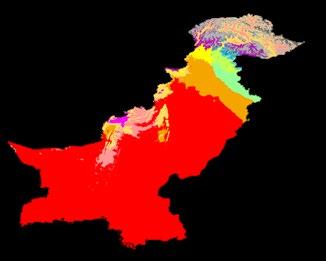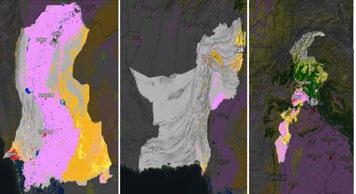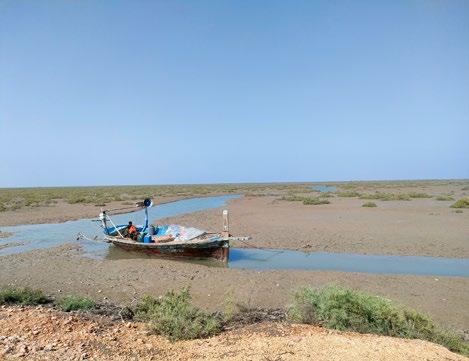
12 minute read
Executive Summary
2.1.2 Pakistan’s Migration Profile
To understand the status of and reasons for migration patterns within Pakistan, it is important to reflect on the history and geography of the country which has a significant role in influencing migration patterns today. In the late nineteenth and early twentieth century, mass migration in the Subcontinent occurred as a response to the establishment of agricultural colonies and canal networks, constructed for irrigation purposes. The British established cantonments in parts of Bahawalpur, Peshawar, Karachi, and other areas which attracted migrants and subsequently grew into mega urban settlements. The farming communities, or the ‘cultivating castes’, were also settled by the British in regions like Faisalabad (Eastern Punjab) and later in parts of Bahawalpur (a princely state at the time) and Bahawalnagar. Similarly, after the construction of the Sukkur Barrage, people from Punjab settled in areas of Sindh (Sukkur and later in Sanghar) and the construction of Ghulam Muhammad Barrage was followed by migrations of people from Punjab to Badin (Sindh)²⁸. Most people in the North-West Frontier Province (NWFP) region, now called Khyber Pakhtunkhwa, made migrations into Peshawar and other cantonments in the same province, while cantonments in Karachi and Bahawalpur received migrations from Punjab. Following the creation of Pakistan in 1947, there was an influx of migrants to the country, followed by accelerated rural to urban migrations, where approximately two million people mainly settled in Punjab and Sindh as the population grew rapidly. The pace of urbanisation then continued slowly until the early 1950s. The next great wave of migration took place during the separation of East and West Pakistan, creating irregular migrants out of former citizens. The third landmark cross-border migration followed after the Afghan crisis in 1978, where approximately three million refugees settled in parts of Karachi and various regions in Balochistan and the Khyber Pakhtunkhwa. The influx of Afghan immigrants, especially in the Pakistani Pashtun province, resulted in high outward migration flows of Pakistani nationals leaving to work in oil rich countries.²⁹
Advertisement
These waves of migration were not one-off events but instead continued to attract cross-border movements into Pakistan. Several internal migration streams followed before people permanently settled down.³⁰ The rural-urban and cross-border migration patterns were set mainly as a result of the three historic streams outlined above. The current movement of people can be traced to the same patterns, where people move for work, to reunite with family or to meet family in ancestral lands, or due to shared cultural, religious, and traditional values.
The causes of migration in Pakistan, in particular internal migration, lack thorough research and analysis primarily due to lack of data. But a handful of research on patterns of inter and intra-province migration present interesting results that help to shed some light on the patterns of current climate induced migration in Pakistan.
Contrary to popular belief, unemployment and differences in earnings between origin and destination are not the only influence in rural-urban migration decisions; economic growth and inequality are also significant factors. “Macro-economic variables of interest include health, education, marriage, infrastructure, informational and migrant networks at the destination, as well as poverty, population density and landlessness at the place of origin.”³¹ The provision of public utilities, such as electricity, clean-piped water, and gas, are also essential considerations in the migration decision.
According to estimates from the 2014-2015 Labour Force Survey (LFS), the number of Pakistani people involved in internal migration is roughly four times the number of people moving abroad. This means that approximately 13 per cent of the Pakistani population are internal migrants. The main motivations are marriage (35 per cent), migration with family (21 per cent) and employment purposes (16.5 per cent).³² According to a recent IOM report, a quarter of the total migration flows are from rural to urban.³³ According to Mahmud et al. (2018), 60 per cent of all internal migrations within Pakistan are towards urban centers (either from a rural district or from another urban district).³⁴ According to another study by Arif (2005), 40 per cent of internal migrations are from rural to urban areas, a majority of which are undertaken by males (60 per cent) for economic reasons.³⁵ Another detailed study by Memon (2005) outlines that approximately 21 per cent of the total migrants are economic migrants, while the rest migrate with family or for marriage. The province of Sindh receives significant inflows of net migration from other provinces. Punjab also receives migration from Khyber Pakhtunkhwa, Sindh, and other districts of Punjab, while Balochistan has experienced migration outflows, especially to Sindh. Khyber Pakhtunkhwa outstrips Punjab as the main source of inter-provincial migrations, mainly because a large number of migrants from KP have settled in Punjab.³⁶ A study by Khatak (2004) focuses on migration patterns within Khyber Pakhtunkhwa. He found that the majority of people in Khyber Pakhtunkhwa migrated to other districts within the province. Most of these were young people who migrated for non-economic reasons and only 8.4 per cent migrated for business purposes. Naeem (2004) found that outflows of migrants from Punjab were greater than inflows into Punjab by other regions. Rukanuddin and Chaudhry (2004) highlight migrant patterns from Sindh and observed that two-thirds of the migrants moved within different areas of Sindh, while the remainder moved to other provinces for economic reasons.³⁷
Pakistan is also subject to a vast array of natural and man-made assisted hazards, which have caused numerous waves of internal displacement and internal migration. Approximately three million people are affected by natural catastrophes annually, which equates to approximately 1.6 per cent of the total population.³⁸
2.1.3 Pakistan’s Climate Risk Profile
Pakistan’s climate is as varied as the country’s topography: dry and hot near the coast and along the lowland plains of the Indus River and progressively cooler in the Northern uplands and Himalayas. The high population density and vastly diverse terrain make Pakistan especially vulnerable to climate change impacts.³⁹ The Eastern regions of the Southern half of the country mainly receive precipitation through monsoon rains in the summer (June to September), while the Western and Northern regions of the Southern half receive precipitation mainly through Western weather disturbances in the winter season (December to March). Most regions of the country receive very little rainfall, with the exception of the Northern regions, where monsoons can bring rain upwards of 200 millimeters a month from July to September.
In 2020, Pakistan ranked as the fifth most vulnerable country to climate change in the Global Climate Risk Index.⁴⁰ High and rising temperatures, increased intensity and frequency of weather-related disasters and events, melting of the glaciers in the North, especially the Himalayan glaciers, alongside the increased variability of monsoon rains, are but a few of the high degree impacts facing the country.⁴¹
Köppen-Geiger climate classification map for Pakistan (1980-2016)

Source: Köppen-Geiger climate classification maps⁴²
Figure 2: Climate classification map of Pakistan
According to a report by the International Monetary Fund (IMF), Pakistan ranks third on the list of countries facing water shortages.⁴³ According to the Pakistan Council of Research in Water Resources (PCRWR), the country is at the brink of reaching ‘absolute scarcity’ of water by 2025.⁴⁴ A holistic study of past environmental trends shows that the Indus Basin has been affected by droughts since the 19th century. Climate change threatens to make droughts much worse and frequent than before. being degraded, water resources are polluted and mangrove forests are diminishing. As a result, local communities are facing food insecurity and loss of livelihoods that force them to migrate to other parts of the country and across borders.⁴⁵ Similarly, parts of the Balochistan province, especially District Badin, have been impacted by climate change in the form of extreme sea intrusion as far as 85 km up the fresh water channels, causing extreme water shortage for consumption. Thousands of people have migrated away from this area as agricultural production has decreased from 82,200 hectares in 2001–2002 to 61,900 hectares in 2016.⁴⁶
2.1.4 Pakistan’s Climate–Migration Nexus
All over the world, for centuries people have undertaken seasonal or circular migrations as a way of life. The majority of these people come from rural agricultural backgrounds who migrate in search of employment and return home when the season is right for crop production activities. In the past decade, climate change has increasingly disrupted this system and forced communities into permanent migrations. Climate change creates migrants in a number of ways, including when climate change induced disasters displace people for shelter; sea level rises, forcing people to move inland and events like deforestation, overgrazing and drought-like situations destroy crops and kill livestock, leaving no choice for farmers and their families but to migrate elsewhere for work.⁴⁷
The same is true for Pakistan, which is a developing country comprised of mostly dry and arid land, where the majority of the population, directly or indirectly, relies on the agriculture sector for their livelihood and daily sustenance. The sector not only employs half of the labour force but is also the largest source of the country’s foreign exchange earnings.⁴⁸
According to officials and local experts, extreme weather patterns, shrinking viable land for agricultural production, sea erosion and lingering dry spells have caused widespread migration within Pakistan in the past decade. Seasonal migrations are turning into long-term migrations. Displaced communities sometimes do not return back. Forced migration is becoming more common as people have no option but to migrate, and in some instances, people would rather die than be forced to move.
Increasing patterns of migration in various parts of the country have become an area of concern. The increased frequency and intensity of extreme weather events threaten food supplies and jeopardize livelihoods, separating families and driving entire households away from their place of residence. All of these effects increase the risk of poverty, hunger, and conflict, particularly among the most vulnerable. Climate induced migration is not restricted to any one region in Pakistan. The patterns of forced migration can be seen all over the country. In Khyber Pukhtunkhwa, the challenges are multi-faceted; which are exacerbated by cross-border conflict spill-over. Its different regions are exposed to GLOFs, flash flooding, riverine flooding, and droughts. In Sindh, as outlined above, coastal communities are bearing the brunt of sea intrusion. Recent reports suggest that, on the current trajectory of rising sea level, Karachi will be completely submerged by 2060, and Thatta and Badin districts could be submerged by 2050.⁴⁹
Drought is another major concern for Pakistan. Moderate to severe drought conditions have continuously prevailed in parts of South-West Balochistan, Southern Khyber Pakhtunkhwa, SouthEast Sindh, and Southern Punjab for at least the last six years. Sindh and Balochistan provinces are the most affected by recurring droughts, to the extent that the situation is rapidly becoming one of the worst natural disasters that Pakistan has ever witnessed. Upland areas of these affected provinces have witnessed minimal to no summer rainfalls, leading to a severe shortage of water resources and drying up of tube wells and springs. This has resulted in a drop in the underground water table in the low lying regions and valleys. Water unavailability disrupts the entire social fabric of communities, leading to food, health, and economic insecurities, compelling people into conflict over scarce resources and ultimately forcing them to migrate out of their regions.⁵⁰
In the case of Balochistan and Sindh, lengthy dry spells have led the rural population to migrate to barrage areas in order to seek employment, food, and water for their families and livestock. According to Pakistan’s Meteorological Department (PMD), 33 per cent of the population from the districts of Chagai, Noshki, Kharan and Washuk have migrated away from their land.⁵¹
Similarly, the Chitral district in Khyber Pakhtunkwa is one of the districts that have been severely affected by the impacts of climate change, as water scarcity and infertility of land in this area forced its resident communities to migrate out of their homes. People in Gilgit Baltistan have also been forced to migrate due to frequent torrential rains and flash floods. Continuous droughts in 26 districts of Sindh and Balochistan⁵² are further examples of how climate change is capable of causing humanitarian disasters, where the prolonged El Nino droughts in the regions have affected more than five million people. The drought in Thar dessert caused the death of 257 children in the first quarter of 2019.⁵³ In Jacobabad, Sindh, the temperatures rose to such great levels – over 52 degree Celsius – that they surpassed the threshold of “too hot for human tolerance.”⁵⁴ Each region of Pakistan is dealing with different effects of climate change. High dependency on agriculture and fishing and unplanned urbanisation, compound with adverse climatic impacts, force people to migrate towards cities. A warmer climate has now become unavoidable, but how we respond to climate change will determine the magnitude of the costs and consequences that we will face. For a nation that lacks resources, resilience to disasters and good governance, the stress that climate change induced migration will bring will shake the country’s stability and stir conflicts. Figure 2 shows maps of three regions, showing land cover loss or built-up (urbanisation) of land covered by buildings and other man-made structures which clearly shows that migration has taken place towards all urban centers.

Figure 3 : Land cover showing land loss or built-up in Sindh, Balochistan, and Khyber Pakhtunkhwa Source: Copernicus Global Land Service
Forests
Shrubland
Herbaceous vegetation
Herbaceous wetland
Moss & lichen
Bare/sparse vegetation
Cropland
Built-up (Urbanisation)
Snow & ice
Permanent water bodies
2.2 Research Methodology
2.2.1 Research Overview
This research is the first in a series of preliminary studies aimed at generating vital debate based on evidence from the field. This particular report aims to highlight and acknowledge the presence of climate induced migrants in Pakistan and make arguments towards convincing the global community of the need to protect and facilitate migrant communities by adopting tailor-made strategies to mitigate and adapt to the impacts of climate change.

This study establishes the urgency of acknowledging the severe impact of climate change on people’s mobility. Migrant communities from Khyber Pakhtunkhwa, Balochistan and Sindh province were identified and interviewed to build case studies that aim to push the agenda for climate change advocacy by identifying new governance mechanisms and social movements needed to fill existing gaps; alongside the economic implications of risks and costs associated with forced migration due to environmental changes. The research focuses heavily on the barriers to mainstreaming the issue of climate induced migration by presenting arguments and insights from the field to inform and challenge the most commonly debated issues and perspectives around climate induced migration. The results obtained will be helpful in formalising a National Climate induced Migration Policy for Pakistan that will specifically highlight the definition of key terms like ‘climate migrant’ and ‘climate migration’ and address the facilitation and/or management of climate induced migration. Such a policy is intended to build on the clause in the National Climate Change Policy 2012 regarding ‘curbing rural-to-urban migration’. This is crucial because climate migration is often confused with economic migration and presented as something that needs to be slowed or reduced, without exploring the depths and causes of the widespread migrations. To bring appropriate focus to people displaced due to climate change impacts, it is important that they are distinguished and facilitated accordingly.










